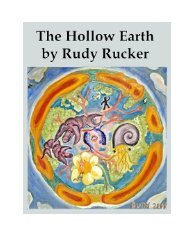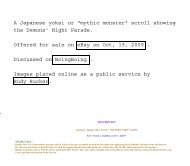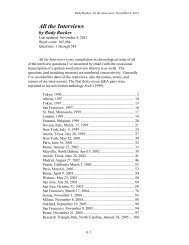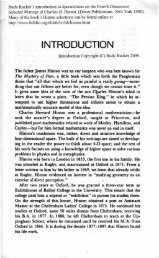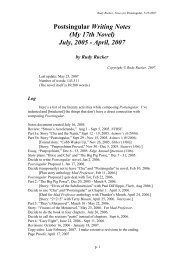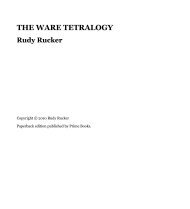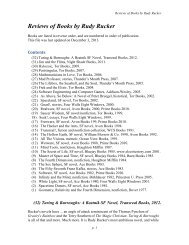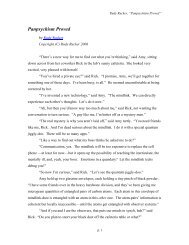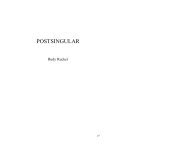Notes for the Lifebox, the Seashell, and the Soul - Rudy Rucker
Notes for the Lifebox, the Seashell, and the Soul - Rudy Rucker
Notes for the Lifebox, the Seashell, and the Soul - Rudy Rucker
Create successful ePaper yourself
Turn your PDF publications into a flip-book with our unique Google optimized e-Paper software.
<strong>Notes</strong> <strong>for</strong> The <strong>Lifebox</strong>, <strong>the</strong> <strong>Seashell</strong>, <strong>and</strong> <strong>the</strong> <strong>Soul</strong>, by <strong>Rudy</strong> <strong>Rucker</strong><br />
rocks in terms of <strong>the</strong>ir volume. And we’ll measure <strong>the</strong> “intensity” of <strong>the</strong> rocks of a given<br />
size by counting how many rocks of that type <strong>the</strong>re are.<br />
For simplicity’s sake, I’ll describe a way of getting rocks of different size levels by<br />
repeatedly making copies of <strong>the</strong> existing rocks <strong>and</strong> break <strong>the</strong> copies in two.<br />
• Level 0. Start with a big rock of size 1.<br />
• Level L+1. Make copies of <strong>the</strong> Stage L rocks <strong>and</strong> break each of <strong>the</strong> copies into two equal<br />
pieces.<br />
Admittedly, <strong>the</strong> notion of copying rocks is artificial. But as you can see in <strong>the</strong> figure<br />
below, we could also think in terms of starting with an appropriate number of big rocks <strong>and</strong><br />
breaking each of down to a different level.<br />
[Figure (not drawn)] We can reach L levels of division by starting with L+1 big<br />
rocks <strong>and</strong> shattering each of <strong>the</strong>m through successively more steps.<br />
If we go down to level L, we <strong>the</strong>n have:<br />
• 1 piece of volume 1,<br />
• 2 pieces of volume 1/2,<br />
• 4 pieces of volume 1/4 ... <strong>and</strong><br />
• 2 L pieces of volume 1 / 2 L .<br />
Now in each row, <strong>the</strong> volume of <strong>the</strong> pieces is <strong>the</strong> quantity R = 1/ 2 L on <strong>the</strong> right, <strong>and</strong><br />
<strong>the</strong> number of pieces of that volume is <strong>the</strong> quantity P(R) = 2 L on <strong>the</strong> left. If I combine <strong>the</strong><br />
two equations I get:<br />
P(R) = 1 / R<br />
So in this case, as promised, we have a power law with D = 1.<br />
Now let’s ring in a change. Suppose we think of <strong>the</strong> rocks as cubes, <strong>and</strong> that we<br />
measure <strong>the</strong>ir size in terms of <strong>the</strong>ir edge length instead of <strong>the</strong>ir volume? And let’s also<br />
suppose that when we break a cube in two, we can, without changing <strong>the</strong> total volume, knead<br />
<strong>the</strong> pieces like clay so that <strong>the</strong>y too are little cubes. In this case, we’d have:<br />
• 1 piece of edge 1,<br />
• 2 pieces with an edge equal to <strong>the</strong> cube root of 1/2,<br />
• 4 pieces with an edge equal to <strong>the</strong> cube root of 1/4 ... <strong>and</strong><br />
• 2 L pieces with an edge equal to <strong>the</strong> cube root of 1 / 2 L .<br />
If we write R <strong>for</strong> <strong>the</strong> edge length, <strong>the</strong>n at level L, R 3 equals 1 / 2 L , <strong>and</strong> <strong>the</strong> reciprocal<br />
of this is <strong>the</strong> same as <strong>the</strong> intensity P(R) = 2 L . So we get this kind of power law.<br />
P(R) = 1 / R 3<br />
If you don’t like <strong>the</strong> idea of kneading <strong>the</strong> pieces into cubes, you could instead be<br />
cutting each cube into eight pieces.<br />
1 piece of edge 1,<br />
8 pieces of edge 1/2,<br />
64 pieces of edge 1/4 ... <strong>and</strong><br />
8 L pieces of edge 1 / 2 L .<br />
Now here, since 8 L is <strong>the</strong> same as (2 L ) 3 , we again have<br />
P(R) = 1 / R 3 p. 87



